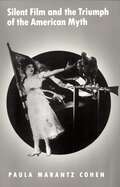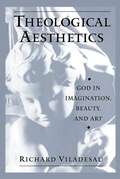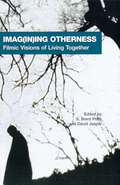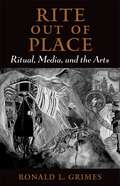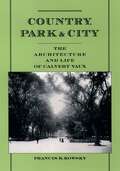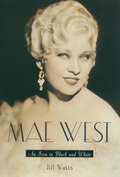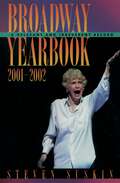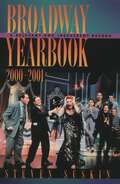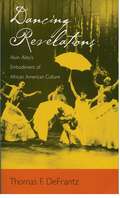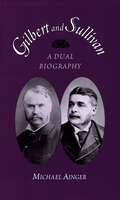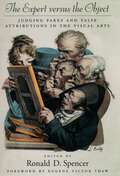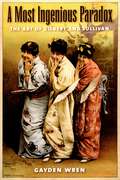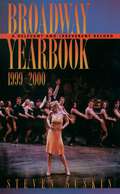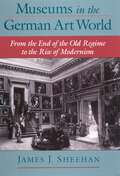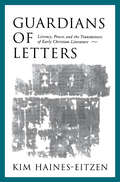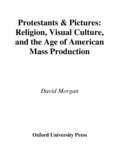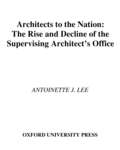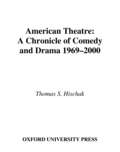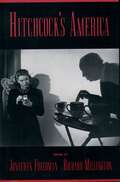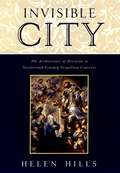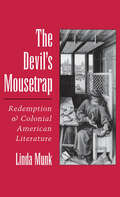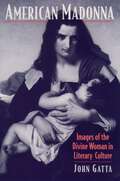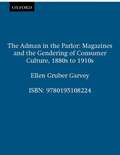- Table View
- List View
Silent Film and the Triumph of the American Myth
by Paula Marantz CohenSilent Film and the Triumph of the American Myth connects the rise of film and the rise of America as a cultural center and twentieth-century world power. Silent film, Paula Cohen reveals, allowed America to sever its literary and linguistic ties to Europe and answer the call by nineteenth-century writers like Emerson, Thoreau and Whitman for an original form of expression compatible with American strengths and weaknesses. When film finally began to talk in 1927, the medium had already done its work. It had helped translate representation into a dynamic visual form and had "Americanized" the world. Cohen explores the way film emerged as an American medium through its synthesis of three basic elements: the body, the landscape, and the face. Nineteenth-century American culture had already charged these elements with meaning--the body through vaudeville and burlesque, landscape through landscape painting and moving panoramas, and the face through portrait photography. Integrating these popular forms, silent film also developed genres that showcased each of its basic elements: the body in comedy, the landscape in the western, and the face in melodrama. At the same time, it helped produce a new idea of character, embodied in the American movie star. Cohen's book offers a fascinating new perspective on American cultural history. It shows how nineteenth-century literature can be said to anticipate twentieth-century film--how Douglas Fairbanks was, in a sense, successor to Walt Whitman. And rather than condemning the culture of celebrity and consumption that early Hollywood helped inspire, the book highlights the creative and democratic features of the silent-film ethos. Just as notable, Cohen champions the concept of the "American myth" in the wake of recent attempts to discredit it. She maintains that American silent film helped consolidate and promote a myth of possibility and self-making that continues to dominate the public imagination and stands behind the best impulses of our contemporary world.
Theological Aesthetics: God in Imagination, Beauty, and Art
by Richard ViladesauThis book explores the role of aesthetic experience in our perception and understanding of the holy. Richard Viladesau's goal is to articulate a theology of revelation, examined in relation to three principal dimensions of the aesthetic realm: feeling and imagination; beauty (or taste); and the arts. After briefly considering ways in which theology itself can be imaginative or beautiful, Viladesau concentrates on the theological significance of aesthetic data provided by each of the three major spheres of aesthetic perception and response. Throughout the work, the underlying question is how each of these spheres serves as a source (however ambiguous) of revelation. Although he frames much of his argument in terms of Catholic theology--from the Church Fathers to Karl Rahner, Hans urs von Balthasar, Bernard Lonergan, and David Tracy--Viladesau also makes extensive use of ideas from the Protestant theologian of the arts Gerardus van der Leeuw, and draws insights from such diverse thinkers as Hans Goerg Gadamer, Wolfhart Pannenberg, and Iris Murdoch. His analysis is enlivened by the artistic examples he selects: the music of Mozart as contemplated by Karl Barth, Schoenbergs opera Moses und Aron, the sculptures of Chartres Cathedral, poems by Rilke and Michelangelo, and many others. What emerges from this study is what Viladeseau terms a transcendental theology of aesthetics. In Thomistic terms, he finds that beauty is not only a perfection but a transcendental. That is, any instance of beauty, rightly perceived and rightly understood, can be seen to imply divinely beautiful things as well. In other words, Viladesau argues, God is the absolute and necessary condition for the possibility of beauty.
Imag: Filmic Visions of Living Together (AAR Cultural Criticism Series)
by S. Brent Plate David JasperImag(in)ing Otherness explores relationships between film and religion, aesthetics and ethics. The volume examines these relationships by viewing how otherness is imaged in film and how otherness alternately might be imagined. Drawing from a variety of films from differing religious perspectives--including Chan Buddhism, Hinduism, Native American religions, Christianity, and Judaism--the essays gathered in this volume examine the particular problems of "living together" when faced with the tensions brought out through the otherness of differing sexualities, ethnicities, genders, religions, cultures, and families.
Rite out of Place: Ritual, Media, and the Arts
by Ronald L. GrimesMuch ritual studies scholarship still focuses on central religious rites. For this reason, Grimes argues, dominant theories, like the data they consider, remain stubbornly conservative. This book issues a challenge to these theories and to popular conceptions of ritual. Rite Out of Place collects 10 revised essays originally published in widely varied sources across the past five years. Grimes has selected for inclusion those essays that track ritual as it haunts the edges of cultural boundaries-ritual converging with theater, ritual on television, ritual at the edge of natural environments and so on. The writing is non-technical, and the implied audience is sufficiently broad than any educated person interested in religion and public life should find it intelligible and engaging.
Country, Park And City: The Architecture And Life Of Calvert Vaux
by Francis R. KowskyAfter beginning his architectural career in England, Calvert Vaux came to America in 1850 at the invitation of architect Andrew Jackson Downing. In 1852, he moved to New York City and asked Frederick Law Olmsted, the landscape architect, to join him in preparing a design for Central Park.During the next thirty-eight years in New York, Vaux defended and refined his vision of Central Park and pursued a distinguished architectural practice. After the Civil War, he and Olmsted led the nascent American park movement with their designs for parks in many American cities. And as apioneering advocate for apartment houses in American cities, Vaux designed buildings that mirrored the advance of urbanization in America, including early model-housing for the poor. His works also include many Gothic and Palladian style dwellings, the original portions of the Metropolitan Museum ofArt and the American Museum of Natural History, and a stunning proposal for a vast iron and glass building to house the Centennial Exhibition in Philadelphia. Most notable, perhaps, are the many bridges and other structures that he designed for Central Park. This book is the first in-depth study ofVaux's life and work.
Country, Park & City: The Architecture and Life of Calvert Vaux
by Francis R. KowskyAfter beginning his career as an architect in London, Calvert Vaux (1824-1895) came to the Hudson River valley in 1850 at the invitation of Andrew Jackson Downing, the reform-minded writer on houses and gardens. As Downing's partner, and after Downing's death in 1852, Vaux designed country and suburban dwellings that were remarkable for their well-conceived plans and their sensitive rapport with nature. By 1857, the year he published his book Villas and Cottages, Vaux had moved to New York City. There he asked Frederick Law Olmsted to join him in preparing a design for Central Park. He spent the next 38 years defending and refining their vision of Central Park as a work of art. After the Civil War, he and Olmsted led the nascent American park movement with their designs for parks and parkways in Brooklyn, Buffalo, and many other American cities. Apart from undertakings with Olmsted, Vaux cultivated a distinguished architectural practice. Among his clients were the artist Frederic Church, whose dream house, Olana, he helped create; and the reform politician Samuel Tilden, whose residence on New York's Gramercy Park remains one of the country's outstanding Victorian buildings. A pioneering advocate for apartment houses in American cities, Vaux designed buildings that mirrored the advance of urbanization in America, including early model housing for the poor. He planned the original portions of the Metropolitan Museum of Art and the American Museum of Natural History and conceived a stunning proposal for a vast iron and glass building to house the Centennial Exhibition in Philadelphia. Especially notable are the many bridges and other charming structures that he designed for Central Park. Vaux considered the Park's Terrace, decorated by J. W. Mould, as his greatest achievement. An active participant in the cultural and intellectual life of New York, Vaux was an idealist who regarded himself as an artist and a professional. And while much has been written on Olmsted, comparatively little has been published about Vaux. The first in-depth account of Vaux's career, Country, Park, and City should be of great interest to historians of art, architecture, and urbanism, as well as preservationists and other readers interested in New York City's past and America's first parks.
Mae West: An Icon in Black and White
by Jill Watts"Why don't you come up and see me sometime?" Mae West invited and promptly captured the imagination of generations. Even today, years after her death, the actress and author is still regarded as the pop archetype of sexual wantonness and ribald humor. But who was this saucy starlet, a woman who was controversial enough to be jailed, pursued by film censors and banned from the airwaves for the revolutionary content of her work, and yet would ascend to the status of film legend? Sifting through previously untapped sources, author Jill Watts unravels the enigmatic life of Mae West, tracing her early years spent in the Brooklyn subculture of boxers and underworld figures, and follows her journey through burlesque, vaudeville, Broadway and, finally, Hollywood, where she quickly became one of the big screen's most popular--and colorful--stars. Exploring West's penchant for contradiction and her carefully perpetuated paradoxes, Watts convincingly argues that Mae West borrowed heavily from African American culture, music, dance and humor, creating a subversive voice for herself by which she artfully challenged society and its assumptions regarding race, class and gender. Viewing West as a trickster, Watts demonstrates that by appropriating for her character the black tradition of double-speak and "signifying," West also may have hinted at her own African-American ancestry and the phenomenon of a black woman passing for white. This absolutely fascinating study is the first comprehensive, interpretive account of Mae West's life and work. It reveals a beloved icon as a radically subversive artist consciously creating her own complex image.
Broadway Yearbook 2001-2002: A Relevant and Irreverent Record (Broadway Yearbook)
by Steven SuskinCalled the "theater equivalent of longtime New Yorker film critic Pauline Kael" by Matinee Magazine, critic and producer Steven Suskin chronicles the 2001-2002 theater season in his latest installment in the Broadway Yearbook series. Commenting with wit and erudition on each show that opened on Broadway between May 2001 and May 2002, Suskin's vivid descriptions recall Tony winners like Thoroughly Modern Millie and Urinetown and commercial smashes like Mamma Mia! and The Graduate. A great read for theater buffs, the book is also a valuable sourcebook for critics, Broadway historians, and theater professionals, providing an array of statistics on every Broadway production of the season, as well as noteworthy off-Broadway performances. The intelligent and witty Broadway Yearbook, 2001-2002 will engage theater lovers, performers, and critics alike.
Broadway Yearbook 2000-2001: A Relevant and Irreverent Record (Broadway Yearbook)
by Steven SuskinBroadway Yearbook 2000-2001 is a relevant and irreverent record of the theatrical year. A vivid album of the year on the Great White Way, Broadway Yearbook gives readers front-row seats for the phenomenon of The Producers and the rest of the season's hits and misses. Steven Suskin's acclaimed new theatre annual delivers a vibrant, candid, and thoughtful account of every show to hit the boards: exciting musicals such as The Full Monty and the revival of 42nd Street; intriguing new plays like Proof and The Tale of the Allergist's Wife; and fascinating failures, including Jane Eyre and the beleaguered Seussical. Broadway Yearbook tells us what the shows were actually like. It is an interpretive record, featuring not only dates and names but also the stories behind the statistics. Each entry is accompanied by credits and cast lists, scorecards summarizing overall critical reception for each show, a summary of each show's financial performance, and copies of the illustrative program covers and title pages. Appendices provide a roundup of the season's major awards, memorable performances of the year, obituaries, long run leaders, shows still running from prior seasons, scheduled shows that never reached Broadway, and a comprehensive index. Steven Suskin has provided a unique and detailed record of the season's memorable moments and high points (and low points as well). Written from an insider's perspective, the book is knowledgeable, intriguing, provocative, and entertaining. Broadway Yearbook brings the shows of the 2000-2001 season back for an encore.
Dancing Revelations: Alvin Ailey's Embodiment of African American Culture
by Thomas F. DeFrantzIn the early 1960s, the Alvin Ailey American Dance Theater was a small, multi-racial company of dancers that performed the works of its founding choreographer and other emerging artists. By the late 1960s, the company had become a well-known African American artistic group closely tied to the Civil Rights struggle. In Dancing Revelations, Thomas DeFrantz chronicles the troupe's journey from a small modern dance company to one of the premier institutions of African American culture. He not only charts this rise to national and international renown, but also contextualizes this progress within the civil rights, women's rights, and gay rights struggles of the late 20th century. DeFrantz examines the most celebrated Ailey dances, including Revelations, drawing on video recordings of Ailey's dances, published interviews, oral histories, and his own interviews with former Ailey company dancers. Through vivid descriptions and beautiful illustrations, DeFrantz reveals the relationship between Ailey's works and African American culture as a whole. He illuminates the dual achievement of Ailey as an artist and as an arts activist committed to developing an African American presence in dance. He also addresses concerns about how dance performance is documented, including issues around spectatorship and the display of sexuality, the relationship of Ailey's dances to civil rights activism, and the establishment and maintenance of a successful, large-scale Black Arts institution. Throughout Dancing Revelations, DeFrantz illustrates how Ailey combined elements of African dance with motifs adapted from blues, jazz, and Broadway to choreograph his dances. By re-interpreting these tropes of black culture in his original and well-received dances, DeFrantz argues that Ailey played a significant role in defining the African American cultural canon in the twentieth century. As the first book to examine the cultural sources and cultural impact of Ailey's work, Dancing Revelations is an important contribution to modern dance history and criticism as well as African-American studies.
Gilbert and Sullivan: A Dual Biography
by Michael Ainger'A Gilbert is of no use without a Sullivan.' With these words, W.S. Gilbert summed up his reasons for persisting in his collaboration with Arthur Sullivan despite the combative nature of their relationship. In fact, Michael Ainger suggests in Gilbert and Sullivan the success of the pair's work is a direct result of their personality clash, as each partner challenged the other to produce his best work. After exhaustive research into the D'Oyly Carte collection of documents, Ainger offers the most detailed account to date of Gilbert and Sullivan's starkly different backgrounds and long working partnership. Having survived an impoverished and insecure childhood, Gilbert flourished as a financially successful theater professional, married happily and established himself as a property owner. His sense of proprietorship extended beyond real estate, and he fought tenaciously to protect the integrity of his musical works. Sullivan, the product of a supportive family who nourished his talent, was much less satisfied with stability than his collaborator. His creative self-doubts and self-demands led to nervous and physical breakdowns, but it also propelled the team to break the successful mode of their earliest work to produce more ambitious pieces of theater, including The Mikado and The Yeoman of the Guards . Offering previously-unpublished draft libretti and personal letters, this thorough double-biography will be an essential addition to the library of any Gilbert and Sullivan fan.
The Expert versus the Object: Judging Fakes and False Attributions in the Visual Arts
by Ronald D. Spencer Eugene Victor ThawThe authenticity of visual art has always commanded the attention of experts, dealers, collectors, and the art-minded public. Is it "real" or "original" is a way of asking what am I buying? What do I own? What am I looking at? And today more sophisticated questions are being asked: How is authenticity determined and what weight does this determination have in court? This book of essays proposes to answer those questions. Three lines of inquiry are basic to determining authenticity: a connoisseur's evaluation, historical documentation or provenance, and scientific testing. A connoisseur is an expert who evaluates the "rightness" of a work based on much careful scrutiny of many works by an artist and familiarity with that artist's usual manner of working with materials. In determining provenance, a researcher traces the physical object from the artist through a chain of ownership to the present owner--simple enough in concept, though it assumes that the documentation is not faked or inaccurate. The goal is to ensure that the object is the same one that left the artist's hand. Scientific testing, although sometimes useful, is often longer on promise than result. Dating paint or wood samples, for instance, can show that a painting was made in Rembrandt's lifetime, but it cannot prove that it is by Rembrandt's hand. If expert opinion is divided, and large sums of money are involved, a dispute over authenticity may end up in a court of law, where evaluation of expert opinion evidence can be problematic. The essays in this book clarify the nature of the methods outlined above and explain, based on case law, the present status of authentication issues in court. Contributors include experts from Christie's, London; Sotheby's, New York; and the former director of the Frick Collection; as well as leading art historians and art dealers; an art conservator; a forensic graphologist; a philanthropist and collector; and a specialist in French art law. Their collective knowledge on issues of authenticity will be invaluable for anyone interested in the world of visual art.
The Avant-Garde in Interwar England: Medieval Modernism and the London Underground
by Michael T. SalerThe Avant-Garde in Interwar England addresses modernism's ties to tradition, commerce, nationalism, and spirituality through an analysis of the assimilation of visual modernism in England between 1910 and 1939. During this period, a debate raged across the nation concerning the purpose of art in society. On one side were the aesthetic formalists, led by members of London's Bloomsbury Group, who thought art was autonomous from everyday life. On the other were England's so-called medieval modernists, many of them from the provincial North, who maintained that art had direct social functions and moral consequences. As Michael T. Saler demonstrates in this fascinating volume, the heated exchange between these two camps would ultimately set the terms for how modern art was perceived by the British public. Histories of English modernism have usually emphasized the seminal role played by the Bloomsbury Group in introducing, celebrating, and defining modernism, but Saler's study instead argues that, during the watershed years between the World Wars, modern art was most often understood in the terms laid out by the medieval modernists. As the name implies, these artists and intellectuals closely associated modernism with the art of the Middle Ages, building on the ideas of John Ruskin, William Morris, and other nineteenth-century romantic medievalists. In their view, modernism was a spiritual, national, and economic movement, a new and different artistic sensibility that was destined to revitalize England's culture as well as its commercial exports when applied to advertising and industrial design. This book, then, concerns the busy intersection of art, trade, and national identity in the early decades of twentieth-century England. Specifically, it explores the life and work of Frank Pick, managing director of the London Underground, whose famous patronage of modern artists, architects, and designers was guided by a desire to unite nineteenth-century arts and crafts with twentieth-century industry and mass culture. As one of the foremost adherents of medieval modernism, Pick converted London's primary public transportation system into the culminating project of the arts and crafts movement. But how should today's readers regard Pick's achievement? What can we say of the legacy of this visionary patron who sought to transform the whole of sprawling London into a post-impressionist work of art? And was medieval modernism itself a movement of pioneers or dreamers? In its bold engagement with such questions, The Avant-Garde in Interwar England will surely appeal to students of modernism, twentieth-century art, the cultural history of England, and urban history.
A Most Ingenious Paradox: The Art of Gilbert and Sullivan
by Gayden WrenWritten more than a century ago and initially regarded even by their creators as nothing more than light entertainment, the fourteen operas of Gilbert & Sullivan emerged over the course of the twentieth century as the world's most popular body of musical-theater works, ranking second only to Shakespeare in the history of English-language theater. Despite this resounding popularity and proven longevity, most books written about the duo have focused on the authors rather than the works. With this detailed examination of all fourteen operas, Gayden Wren fills the void. His bold thesis finds the key to the operas' longevity, not in the clever lyrics, witty dialogue, or catchy music, but in the central themes underlying the characters and stories themselves. Like Shakespeare's comedies, Wren shows, the operas of Gilbert & Sullivan endure because of their timeless themes, which speak to audiences as powerfully now as they did the first time they were performed. Written out of an abiding love for the Savoy operas, this volume is essential reading for any devotee of these enchanting works, or indeed for anyone who loves musical theater.
Broadway Yearbook, 1999-2000: A Relevant and Irreverent Record (Broadway Yearbook)
by Steven SuskinBroadway Season 1999-2000 is a unique and detailed guide to the theatrical year presenting 46 different shows. The volume features a comprehensive discussion of every show that opened on Broadway during the 1999-2000 season as well as several non-Broadway productions of importance or general interest. Each entry is accompanied by credits and cast lists, scorecards summarizing overall critical reception for each show, and a recap of each show's financial performance. A new kind of theatre annual, this distinctive volume discusses what the shows are actually like (instead of merely relying on plot synopses or photographs). It is an interpretive record, featuring not only dates and names but also the stories behind the statistics. Opening night title pages illustrate each show discussion. Appendices include a roundup of the season's major awards, memorable performances of the year, obituaries, long run leaders, shows still running from prior seasons, scheduled shows that never reached Broadway, and a comprehensive index. Steven Suskin has provided a relevant and irreverent record of the year's memorable high points (and low points). Written from an insider's perspective, the book is knowledgeable, intriguing, provocative, and entertaining.
Museums in the German Art World: From the End of the Old Regime to the Rise of Modernism
by James J. SheehanCombining the history of ideas, institutions, and architecture, this study shows how the museum both reflected and shaped the place of art in German culture from the late eighteenth century to the early twentieth century. On a broader level, it illuminates the origin and character of the museum's central role in modern culture. James Sheehan begins by describing the establishment of the first public galleries during the last decades of Germany's old regime. He then examines the revolutionary upheaval that swept Germany between 1789 and 1815, arguing that the first great German museums reflected the nation's revolutionary aspirations. By the mid-nineteenth century, the climate had changed; museums constructed in this period affirmed historical continuities and celebrated political accomplishments. During the next several years, however, Germans became disillusioned with conventional definitions of art and lost interest in monumental museums. By the turn of the century, the museum had become a site for the political and cultural controversies caused by the rise of artistic modernism. In this context, Sheehan argues, we can see the first signs of what would become the modern style of museum architecture and modes of display. The first study of its kind, this highly accessible book will appeal to historians, museum professionals, and anyone interested in the relationship between art, politics, and culture.
Guardians Of Letters: Literacy, Power, And The Transmitters Of Early Christian Literature
by Kim Haines-EitzenProtestants and Pictures: Religion, Visual Culture, and the Age of American Mass Production
by David MorganIn this lavishly illustrated book, David Morgan surveys the visual culture that shaped American Protestantism in the nineteenth and twentieth centuries--a vast record of images in illustrated bibles, Christian almanacs, children's literature, popular religious books, charts, broadsides, Sunday school cards, illuminated devotional items, tracts, chromos, and engravings. His purpose is to explain the rise of these images, their appearance and subject matter, how they were understood by believers, the uses to which they were put, and what their relation was to technological innovations, commerce, and the cultural politics of Protestantism. His overarching argument is that the role of images in American Protestantism greatly expanded and developed during this period.
Architects to the Nation: The Rise and Decline of the Supervising Architect's Office
by Antoinette J. LeeThis unique book traces the evolution and accomplishments of the office that from 1852 until 1939 held a virtual monopoly over federal building design. Among its more memorable buildings are the Italianate U.S. Mint in Carson City, the huge granite pile of the State, War, and Navy Building in Washington, D.C., the towering U.S. Post Office in Nashville, New York City's neo-Renaissance customhouse, and such "restorations" as the ancient adobe Palace of the Governors in Santa Fe. In tracing the evolution of the Office and its creative output, Antoinette J. Lee evokes the nation's considerable efforts to achieve an appropriate civic architecture.
American Theatre: A Chronicle of Comedy and Drama, 1969-2000
by Thomas S. HischakVolume Four of the distinguished American Theatre: A Chronicle of Comedy and Drama series offers a thorough, candid, and fascinating look at the theater in New York during the last decades of the twentieth century.
Hitchcock's America
by Jonathan Freedman Richard MillingtonAlfred Hitchcock's American films are not only among the most admired works in world cinema, they also offer some of our most acute responses to the changing shape of American society in the 1940s, 50s, and 60s. The authors of this anthology show how famous films such as Strangers on a Train, Vertigo, North by Northwest, and Rear Window, along with more obscure ones such as Rope, The Wrong Man, and Family Plot, register the ideologies and insurgencies, the normative assumptions and the cultural alternatives, that shaped these tumultuous decades. They argue that, just as these films occupy a visual landscape defined by the grand monuments of American civic life--Mt. Rushmore, the Statue of Liberty, the United Nations--they are also marked by their preoccupation with the social mores and private practices of mid-century America. Not only are big-city and suburban life the explicit subjects of films like Rear Window and Shadow of a Doubt, so are the forms of experience that emerge within these social spaces, whether the urban voyeurism examined by the former or the intertwining of banality and violence depicted in the latter. Indeed, just about every form of American life that was achieving social power at this time--the national security state; the science and art of psychoanalysis; the privileging of the free-wheeling, improvisatory self; the postwar codification and fissuring of gender roles; road-culture and its ancillary creation, the motel--is given detailed, critical, and mordant examination in Hitchcocks films. The Hitchcock who emerges is not merely the inspired technician and psychological excavator that critics of the past two generations have justly hailed; he is also a cultural critic of remarkable insight and undeniable prescience.
Invisible City: The Architecture of Devotion in Seventeenth-Century Neapolitan Convents
by Helen HillsMore than any other European city, Baroque Naples was dominated by convents. Behind their imposing facades and highly decorated churches, the convents of Naples housed the daughters of the city's most exclusive families, women who, despite their cloistered existence, were formidable players in the city's power structure. Invisible City vividly portrays the religious world of seventeenth-century Naples, a city of familial and internecine rivalries, of religious devotion and intense urban politics, of towering structures built to house the virgin daughters of the aristocracy. Helen Hills demonstrates how the architecture of the convents and the nuns' bodies they housed existed both in parallel and in opposition to one another. She discusses these women as subjects of enclosure, as religious women, and as art patrons, but also as powerful agents whose influence extended beyond the convent walls. Though often ensconced in convents owing to their families' economic circumstances, many of these young women were able to extend their influence as a result of the role convents played both in urban life and in art patronage. The convents were rich and powerful organizations, riven with feuds and prey to the ambitions of viceregal and elite groups, which their thick walls could not exclude. Even today, Neapolitan convents figure prominently in the city's fabric. In analyzing the architecture of these august institutions, Helen Hills skillfully reads conventual architecture as a metaphor for the body of the aristocratic virgin nun, mapping out the dialectic between flesh and stone.
American Madonna: Images of the Divine Woman in Literary Culture (Religion in America)
by John GattaThis book explores a notable if unlikely undercurrent of interest in Mary as mythical Madonna that has persisted in American life and letters from fairly early in the nineteenth century into the later twentieth. This imaginative involvement with the Divine Woman -- verging at times on devotional homage -- is especially intriguing as manifested in the Protestant writers who are the focus of this study: Nathaniel Hawthorne, Margaret Fuller, Harriet Beecher Stowe, Harold Frederic, Henry Adams, and T.S. Eliot. John Gatta argues that flirtation with the Marian cultus offered Protestant writers symbolic compensation for what might be culturally diagnosed as a deficiency of psychic femininity, or anima, in America. He argues that the literary configurations of the mythical Madonna express a subsurface cultural resistance to the prevailing rationalism and pragmatism of the American mind in an age of entrepreneurial conquest.
The Adman in the Parlor: Magazines and the Gendering of Consumer Culture, 1880s to 1910s
by Ellen Gruber GarveyHow did advertising come to seem natural and ordinary to magazine readers by the end of the nineteenth century? The Adman in the Parlor explores readers' interactions with advertising during a period when not only consumption but advertising itself became established as a pleasure. Garvey argues that readers' participation in advertising, rather than top-down dictation by advertisers, made advertizing a central part of American culture. Garvey's analysis interweaves such texts and artifacts as advertising trade journals, magazines addressed to elite, middle class, and poorer readerships, scrapbooks, medical articles, paper dolls, chromolithographed trade cards, and contest rules. She tracks new forms of fictional realism that contained brand name references, courtship stories, and other fictional forms. As magazines became dependant on advertising rather than sales for their revenues, women's magazines led the way in making consumers of readers through the interplay of fiction, editorials, and advertising. General magazines, too, saw little conflict between these different interests. Instead, advertising and fiction came to act on one another in complex, unexpected ways. Magazine stories illustrated the multiple desires and social meanings embodied in the purchase of a product. Garvey takes the bicycle as a case study, and tracks how magazines mediated among competing medical, commercial, and feminist discourses to produce an alluring and unthreatening model of women bicycling in their stories. Advertising formed the national vocabulary. At once invisible, familiar, and intrusive, advertising both shaped fiction of the period and was shaped by it. The Adman in the Parlor unearths the lively conversations among writers and advertisers about the new prevalence of advertising for mass-produced, nationally distributed products.
